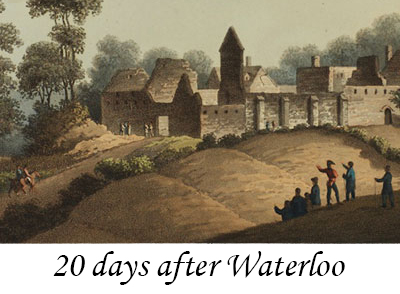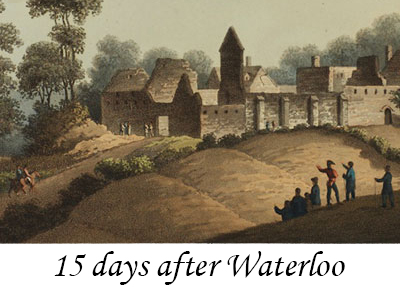In this week’s blog post Professor Emma Clery of the Faculty of English discusses an unsung hero of the war with Napoleon.
‘I deny the insane proposition that peace is more dangerous than war’: Commemorating Samuel Whitbread, 1758-1815
In all the buzz surrounding the bicentenary of the defeat of Napoleon at Waterloo, no mention has been made of the existence of a peace movement in Britain during the long years of war with France. For several years I’ve been exploring the context of the great anti-war poem Eighteen Hundred and Eleven by Anna Letitia Barbauld, a writer well-known in her day. Before I began this research, I confess I wondered what the objection to the war could be, other than moral opposition to all warfare. Napoleon was generally seen by the British as a tyrant with an insatiable appetite for conquest, who must be resisted, right?

WP1/464/29 Copy of a letter from Field Marshal Arthur Wellesley, first Duke of Wellington, to William Wellesley-Pole, concerning Mr. Whitbread’s attack on him in Parliament in connection with Napoleon being declared an outlaw, 5 May 1815
But no. There was organised opposition to the war, and a lot of the leadership came from well-educated, prosperous and socially respectable Dissenters, many of them Unitarians like Barbauld. Their arguments were moral and religious, but also pragmatic, economic and political. They judged that Napoleon’s desire for war with Britain had been exaggerated, and condemned the unwillingness of government to listen to diplomatic approaches from France and her allies. They pointed out that ministers and officials were profiting from the war, and had an interest in prolonging it. At various points in the period 1793 to 1815 they saw opportunities for an honourable negotiated peace with Napoleon and launched nation-wide petition campaigns to put pressure on the war establishment. The peace of Amiens, which lasted for 18 months from 1802-1803, had been very popular. In the years 1808 and 1812 in particular, there seemed to be an opening for new peace negotiations.
During the war years the Whig party, the official opposition in Parliament, was lacking in direction and effectiveness. Their policy on the war wavered. Their long-standing leader Charles James Fox favoured peace, but he only gained power briefly during a coalition government immediately before his death in 1806, and no progress was made. His successors, Lord Holland and Earl Grey, gradually came round to luke-warm backing for the war. The anti-war cause was instead taken up in the House of Commons by radical Whigs, first among them Samuel Whitbread. He was brother-in-law to Grey, but came from a non-aristocratic background. He was the son of a wealthy brewer, and was never allowed to forget these lowly origins in trade by political opponents and by satirists.
Everyone has heard of Nelson and Wellington, but Whitbread is an unsung hero of the war with France. There’s been no proper assessment of this prominent figure on the British political scene since Dean Rapp’s 1970 PhD thesis was published as a book in 1987. I stumbled upon Whitbread’s speeches and activities almost by accident, and it struck me that there was something truly heroic about his dauntless championing of a variety of apparently lost causes, but especially his consistent support for the cause of negotiated peace. There is also something poignant about his death less than three weeks after Waterloo. I didn’t want this anniversary to pass without suggesting a couple of avenues for re-evaluation.
Although Whitbread represented a significant and influential tranche of public opinion at the time, he was marginalised by political opponents and even by members of his own party, and his predictions of disaster were mocked in the Loyalist press. This kind of belittling treatment has continued to the present day, with supposedly objective reference sources like Charles Arnold-Baker’s The Companion to British History and the article by D.R. Fisher on Whitbread in the Oxford Dictionary of National Biography in fact launching bizarre personal attacks on him. This rubbishing of Whitbread goes hand in hand with an uncritical acceptance that the war against Napoleon was unavoidable and British victory was inevitable.
But the trend among the best new histories of Britain’s war against Napoleon, for instance works by Charles Esdaile and Rory Muir, is to take a more nuanced and questioning approach. It’s not unusual to be told nowadays that the British war effort appeared to be doomed up to 1811, or even until early 1813. Although Whitbread’s nay-saying hasn’t yet been given its due, it’s surely only a matter of time before a revisionist account of diplomatic relations backs some of his arguments. The memorable words, ‘I deny the insane proposition that peace is more dangerous than war,’ can be found in an impassioned but closely-argued speech which he delivered in the Commons on the 29th February 1808, criticising the rejection by the Tory government of peace overtures from Russia and Austria. The speech take up 50 columns in printed version records of parliamentary debates, and can be accessed online at
http://hansard.millbanksystems.com/commons/1808/feb/29/mediation-of-russia-and-austria.
Another point arises from Roger Knight’s recent Britain Against Napoleon: The Organization of Victory 1793-1815. The title may seem teleological, as if victory was a foregone conclusion. But actually the conclusions are far more circumspect. Knight goes so far as to argue that possibly the greatest advantage Britain enjoyed seemed to be a weakness: its parliamentary system of government. Napoleon could impose his will without opposition, but, Knight says, ‘while Napoleon had the advantages of continuity and speed of decision, he eventually lost a sense of reality’ (p. 464). The logical consequence of Knight’s argument is that the energetic radical wing of the Whig opposition, the Mountain led by Samuel Whitbread, inadvertently helped in this process of honing the government into a mean and lean fighting machine. By this token even the most hawkish can join in celebrating Whitbread’s contribution.
Whitbread welcomed both the short-lived end of hostilities in 1814, and the victory at Waterloo the following year. But on the 17th June 1815, the day before the battle was fought, he stated in the Commons that, ‘Neither the events of victory or defeat could alter the principle of the war, and his opposition remained unchanged upon that subject’. His view remained that the millions of casualties and the terrible sufferings of soldiers and civilians in the Napoleonic war had been avoidable. On the 5th of July 1815 he committed suicide, aged 57. Speculation about the motive has focused on signs that he was suffering from a mental disturbance at the time, possibly relating to financial difficulties. But there is no doubt that the displays of nationalist triumphalism must have deepened his sense of despair. He would have shared the feeling that Anna Letitia Barbauld described when writing to a friend after the bloodbath at Talavera, Spain, in 1810, from which Wellington emerged as victor:
…I do not know how to rejoice at this victory, splendid as it is, over Buonaparte, when I consider the horrible waste of life, the mass of misery, which such gigantic combats must occasion.
E.J. Clery, University of Southampton
Further Reading:
J.E. Cookson, The Friends of Peace: Anti-War Liberalism in England 1793-1815 (Cambridge: Cambridge University Press, 1982).
Roger Fulford, Samuel Whitbread, 1764-1815: A Study in Opposition (London, Macmillan, 1967).
William McCarthy, Anna Letitia Barbauld: Voice of the Enlightenment (Baltimore: Johns Hopkins University Press, 2008).
Dean Rapp, Samuel Whitbread (1764-1815): A Social and Political Study (New York and London: Garland Publishing, 1987.









![Men's football team, 1953-4 [photo_MS1_7_291_22_4] Men's football team, 1953-4 [photo_MS1_7_291_22_4]](https://live.staticflickr.com/65535/50089268168_f26eed63ef_s.jpg)
![Women's rowing team, 1961-2 [MS1_7_291_22_4] Women's rowing team, 1961-2 [MS1_7_291_22_4]](https://live.staticflickr.com/65535/50090079577_3b7acbde42_s.jpg)
![Men's rugby team, 1953-4 [MS1_7_291_22_4] Men's rugby team, 1953-4 [MS1_7_291_22_4]](https://live.staticflickr.com/65535/50089268523_4f2c587220_s.jpg)
![Women's hockey team, 1953-4 [MS1_7_291_22_4] Women's hockey team, 1953-4 [MS1_7_291_22_4]](https://live.staticflickr.com/65535/50090079692_28114e9c7d_s.jpg)